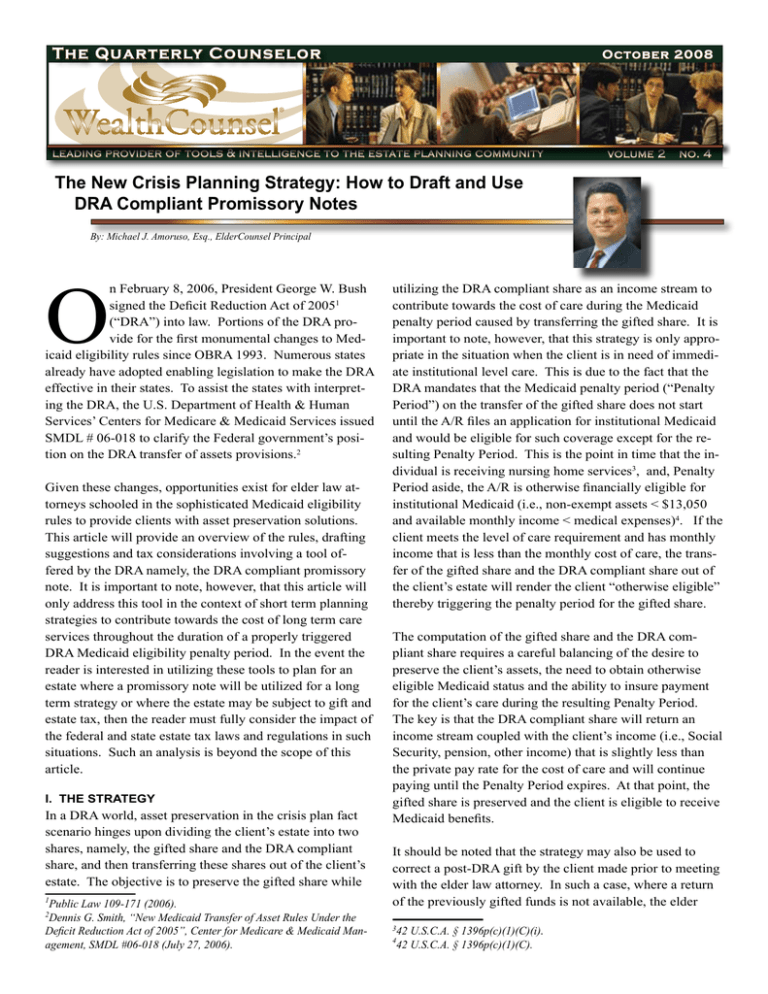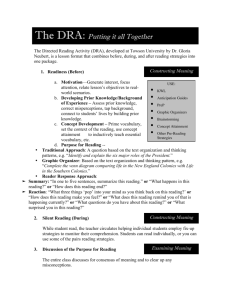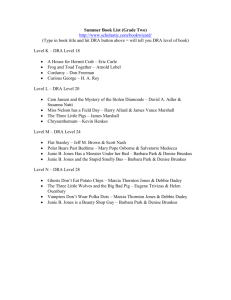
The Quarterly Counselor
October 2008
®
leading provider of tools & intelligence to the estate planning community
volume 2
no. 4
The New Crisis Planning Strategy: How to Draft and Use
DRA Compliant Promissory Notes
By: Michael J. Amoruso, Esq., ElderCounsel Principal
O
n February 8, 2006, President George W. Bush
signed the Deficit Reduction Act of 20051
(“DRA”) into law. Portions of the DRA provide for the first monumental changes to Medicaid eligibility rules since OBRA 1993. Numerous states
already have adopted enabling legislation to make the DRA
effective in their states. To assist the states with interpreting the DRA, the U.S. Department of Health & Human
Services’ Centers for Medicare & Medicaid Services issued
SMDL # 06-018 to clarify the Federal government’s position on the DRA transfer of assets provisions.2
Given these changes, opportunities exist for elder law attorneys schooled in the sophisticated Medicaid eligibility
rules to provide clients with asset preservation solutions.
This article will provide an overview of the rules, drafting
suggestions and tax considerations involving a tool offered by the DRA namely, the DRA compliant promissory
note. It is important to note, however, that this article will
only address this tool in the context of short term planning
strategies to contribute towards the cost of long term care
services throughout the duration of a properly triggered
DRA Medicaid eligibility penalty period. In the event the
reader is interested in utilizing these tools to plan for an
estate where a promissory note will be utilized for a long
term strategy or where the estate may be subject to gift and
estate tax, then the reader must fully consider the impact of
the federal and state estate tax laws and regulations in such
situations. Such an analysis is beyond the scope of this
article.
I. THE STRATEGY
In a DRA world, asset preservation in the crisis plan fact
scenario hinges upon dividing the client’s estate into two
shares, namely, the gifted share and the DRA compliant
share, and then transferring these shares out of the client’s
estate. The objective is to preserve the gifted share while
1
Public Law 109-171 (2006).
G. Smith, “New Medicaid Transfer of Asset Rules Under the
Deficit Reduction Act of 2005”, Center for Medicare & Medicaid Management, SMDL #06-018 (July 27, 2006).
2Dennis
utilizing the DRA compliant share as an income stream to
contribute towards the cost of care during the Medicaid
penalty period caused by transferring the gifted share. It is
important to note, however, that this strategy is only appropriate in the situation when the client is in need of immediate institutional level care. This is due to the fact that the
DRA mandates that the Medicaid penalty period (“Penalty
Period”) on the transfer of the gifted share does not start
until the A/R files an application for institutional Medicaid
and would be eligible for such coverage except for the resulting Penalty Period. This is the point in time that the individual is receiving nursing home services3, and, Penalty
Period aside, the A/R is otherwise financially eligible for
institutional Medicaid (i.e., non-exempt assets < $13,050
and available monthly income < medical expenses)4. If the
client meets the level of care requirement and has monthly
income that is less than the monthly cost of care, the transfer of the gifted share and the DRA compliant share out of
the client’s estate will render the client “otherwise eligible”
thereby triggering the penalty period for the gifted share.
The computation of the gifted share and the DRA compliant share requires a careful balancing of the desire to
preserve the client’s assets, the need to obtain otherwise
eligible Medicaid status and the ability to insure payment
for the client’s care during the resulting Penalty Period.
The key is that the DRA compliant share will return an
income stream coupled with the client’s income (i.e., Social
Security, pension, other income) that is slightly less than
the private pay rate for the cost of care and will continue
paying until the Penalty Period expires. At that point, the
gifted share is preserved and the client is eligible to receive
Medicaid benefits.
It should be noted that the strategy may also be used to
correct a post-DRA gift by the client made prior to meeting
with the elder law attorney. In such a case, where a return
of the previously gifted funds is not available, the elder
U.S.C.A. § 1396p(c)(1)(C)(i).
42 U.S.C.A. § 1396p(c)(1)(C).
342
4
The New Crisis Planning Strategy: How to Draft and Use
DRA Compliant Promissory Notes
By: Michael J. Amoruso, Esq., ElderCounsel Principal
law attorney’s focus will shift from determining the gift
share (since the client already made the gift) to calculating
the appropriate payback timeframe of the DRA compliant
vehicle to obtain “otherwise eligible” status, trigger the
penalty on the previously made gift and insure a payment
stream during the Penalty Period.
II. THE DRA COMPLIANT PROMISSORY NOTE
A promissory note is a transaction where one party purchases (‘Payee”) from another party (“Maker”) the promise
to receive a specified sum with interest over a period of
time. The DRA explicitly excludes funds used to purchase
a promissory note if the note (a) has a repayment term that
is actuarially sound as determined in accordance with actuarial publications of the Office of the Chief Actuary of the
Social Security Administration; (b) provides for payments
to be made in equal amounts during the term of the loan;
(c) does not permit deferral or balloon payments; (d) prohibits the cancellation of the balance upon the death of the
lender.5 Any note that does not comply with all of these
requirements shall be deemed an “asset” for the transfer
of assets provisions of the DRA and the value of the note
will be the outstanding balance of the note on the date of
application.6
a resource in the amount of the outstanding
principal balance.7
In order to avoid treatment as a resource, the elder law
attorney should insure that the promissory note does not
fall into the category of a negotiable instrument as defined
by the Uniform Commercial Code § 3-104. Specifically,
Uniform Commercial Code defines a negotiable instrument
as any writing that (1) is signed by the maker; (2) contains
an unconditional promise or order to pay a sum certain
money; (3) is payable on demand or at a definite time; and
(4) is payable to order or to bearer.8
Complete drafting would suggest that the elder law attorney will draft the note by explicitly stating on the face
of the note that it is non-negotiable, non-assignable and
otherwise not transferable by the Payee. These precautions
should remove the availability of the note from treatment
as an available resource.
Drafting Tip: For added comfort, make the
note even less attractive to a potential third
party buyer. For example, (1) do not provide
for acceleration in the event of default, (2)
do not provide for an incremental increase
in interest rate due to a missed payment or
default, (3) do not add a provision authorizing
the collection of attorneys fees in the event
of default, and (4) do not waive the requirements for presentment, notice of dishonor and
protest – make it difficult for a potential third
party to enforce the note. Obviously, the import of these suggestions must be thoroughly
discussed with the client prior to including
them in any document.
Drafting Tip: As mentioned above, be certain
that the face of the note addresses each of
these DRA requirements. The DRA gratuitously informs us how a note can avoid
transfer of asset treatment and such suggestions should be adhered to by the elder law
attorney.
It is important, however, that the elder law attorney does
not get lost in the trees when drafting a promissory note
that complies with the DRA. Arguably, even a note that
complies with the DRA still may be deemed an available
resource for determining Medicaid eligibility. For example, in New York, the New York State Medicaid Reference
Guide explains that,
A promissory note is a written, unconditional
promise, signed by a person, to pay a specified sum of money at a specified time or on
demand to the person named on the note. A
promissory note, if negotiable, is considered
5
42 U.S.C. § 1396p(c)(1)(I).
Id.
6
2
It is important to note that, practically, the promissory note
is a document that may be easier for the client, the Medicaid caseworker and the elder law attorney to comprehend
and utilize. Unlike a private annuity transaction, the promissory note is not subject to the Internal Revenue Code’s
annuity factors, linear interpolations, interest rate, and calculation of the return of ordinary income and capital gain
with each monthly payment. Instead, the promissory note
merely requires the calculation of a monthly loan amortiza7
8
New York State Medicaid Reference Guide at 269.
UCC § 3-104(1) (McKinney’s 2006).
The New Crisis Planning Strategy: How to Draft and Use
DRA Compliant Promissory Notes
By: Michael J. Amoruso, Esq., ElderCounsel Principal
tion schedule based upon a reasonable rate of interest until
the desired time to zero out the note is reached – typically,
this should be at the expiration of the penalty period. It is
important to remember, however, that the final payment of
the note must be within the life expectancy tables required
by the DRA.
There are, however, tax considerations that must be discussed with the client and their income tax advisor. First,
the interest received by the Payee (our client) will be
considered taxable income. Hopefully, during the time the
note is repaid, the client will be entitled to take the medical expense deduction assuming that the cost paid to the
nursing home exceeds 7.5% of the client’s adjusted gross
income. On the other side of the transaction, assuming that
the Maker deposited the lump sum of principal into an investment account to generate the required interest payment,
the interest generated would be subject to income tax for
the Maker. However, it would be important for the Maker
to consult their accountant to ascertain whether the investment income expenses deduction is available to the Maker.9
1. Fair Hearing Decisions.
Recently, the State of New York has approved the use of a
DRA compliant promissory note to achieve the objective
of this strategy. See Matter of Geraldine A, Matter of Anna
M. and Mary K.
III. PUTTING THE ANNUITY OR PROMISSORY NOTE
INTO PRACTICE:
Case Study for Discussion: Assume the following facts:
Client is 83 year old woman in a New York City nursing
home and has $246,875 in cash. The Private Pay rate is
$360 per day. The client’s income is limited to Social Security and a VA benefit totaling of $1,473 per month. The
New York City regional rate is $9,636 and the Medicaid
individual resource amount is $13,050.
° Causes a 13.06 month penalty period (4//20085/2009)
• Transfer $118,000 in exchange for a DRA compliant
promissory note
° Term (Months): 13
° Interest Rate: 3.45% (April 2008, 7520 Rate)
• Keep $3,000 in Client’s name as she can have up to
the Medicaid resource amount ($13,050 for New
York).
• PN will “zero-out” in 13 months by paying $9,260.64
month (principal and interest)
° April 2008 Private Pay Rate = $10,800
° Total income = $10,733.64 ($1,473 + $9,260.64
Promissory Note Payment)
° Medical expenses exceed income by $66.36 =
OTHERWISE ELIGIBLE!!
• What is preserved?
° $125,875 = 51% !!!! –if interest generated
$123,486.60 = 50% !!!! -if interest paid out of
the gift
As the numbers reveal, with the proper guidance from
an experienced elder law attorney schooled in the DRA
compliant promissory note strategy, the client can properly
preserve assets while insuring that their long term care
expenses are paid with the returning income stream from
the promissory note during the resulting period of Medicaid
ineligibility caused by the gift.
Michael received his B.A. in Economics and Finance from Boston College and his J.D. with a concentration in Taxation from
Boston College Law School. He is licensed to practice law in
New York, Connecticut and Massachusetts and can be reached at
michael@amorusolaw.com.
How will a post DRA promissory note strategy assist this
client? After crunching the numbers to determine the DRA
compliant share, the gifted share and the amount to retain
in the Client’s name the following asset preservation can be
achieved:
• Gift $125,875
9
Consult IRS Form 4952 to determine whether or not applicable.
© 2008 WealthCounsel LLC. WealthCounsel® is a registered trademark of WealthCounsel LLC. All rights reserved. This reprint used with express permission
of WealthCounsel. If you would like reprint permission for this, or any other article from The Quarterly Counselor, contact WealthCounsel at
marlene.frith@wealthcounsel.com or at 888.659.4069 xt. 817.



